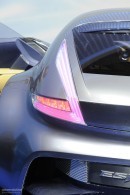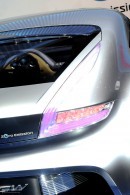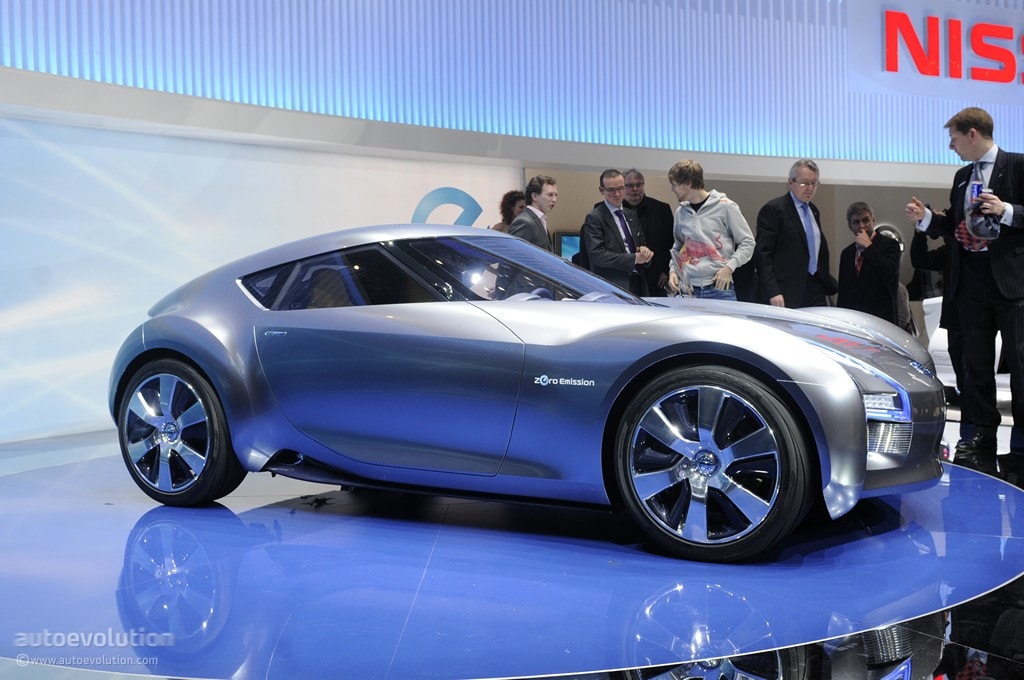The only non-production vehicle present at Nissan’s stand in Geneva is the ESFLOW concept, a car that made wits world debut at the Swiss venue today. Coming as a pure EV sports car, the ESFLOW on display at the event is inspired by glaciers, or as Nissan explains boasting “highly reflective solidified liquid with blue tints in its shadows”.
The vehicle’s headlights and Nissan emblem are tinted cool blue. The six spoke wheels contain blue carbon inserts while the same material adorns the side sill, roof mounted lip spoiler and lower rear bumper. Blue LEDs accentuate the futuristic lights slashed into the bodywork both front and rear.
The interior is reportedly both eco-friendly and luxurious. Highlights inside include the steel framed, thickly upholstered and increasingly motorised seats. Moreover, the fly-by-wire steering and pedals adjust electrically to the best spot to suit each individual driver’s size and preferred driving position.
The seats are upholstered in gold leather and perforated gold suede while the doors are trimmed in dark blue leather and suede. The blue and gold motif, the colour of sparks, is continued across the dashboard, which is also adorned with silver carbon trim, and features four multifunction illuminated LCD displays.
Performance wise, the vehicle is rear-wheel drive and it runs on two electric motors that are placed above the axis of the rear wheels, in a mid-ship position. Power comes from lithium-ion battery packs, the same as those used in the Nissan LEAF, which enable the car to travel over 240 km (150 miles) on one charge.
“These motors independently control the left and right wheels, and so the torque is optimised to ensure outstanding vehicle stability and control as well as efficient power regeneration. The motors produce enough torque in an instant for it to reach 100kph in under 5 seconds,” a company statement reads.
The vehicle’s headlights and Nissan emblem are tinted cool blue. The six spoke wheels contain blue carbon inserts while the same material adorns the side sill, roof mounted lip spoiler and lower rear bumper. Blue LEDs accentuate the futuristic lights slashed into the bodywork both front and rear.
The interior is reportedly both eco-friendly and luxurious. Highlights inside include the steel framed, thickly upholstered and increasingly motorised seats. Moreover, the fly-by-wire steering and pedals adjust electrically to the best spot to suit each individual driver’s size and preferred driving position.
The seats are upholstered in gold leather and perforated gold suede while the doors are trimmed in dark blue leather and suede. The blue and gold motif, the colour of sparks, is continued across the dashboard, which is also adorned with silver carbon trim, and features four multifunction illuminated LCD displays.
Performance wise, the vehicle is rear-wheel drive and it runs on two electric motors that are placed above the axis of the rear wheels, in a mid-ship position. Power comes from lithium-ion battery packs, the same as those used in the Nissan LEAF, which enable the car to travel over 240 km (150 miles) on one charge.
“These motors independently control the left and right wheels, and so the torque is optimised to ensure outstanding vehicle stability and control as well as efficient power regeneration. The motors produce enough torque in an instant for it to reach 100kph in under 5 seconds,” a company statement reads.


















